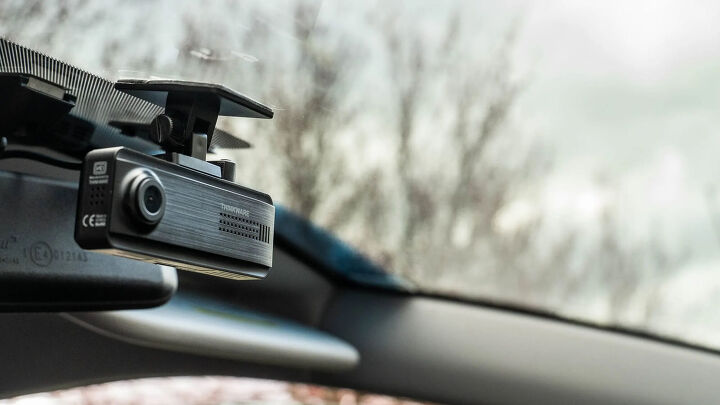
Dash cams give you the chance to to protect yourself, in a liability sense, after a collision. They also give you the chance to review your driving should you do some spirited back-road running on a weekend.
To that end, earlier this year I tested the ThinkWare F200 Pro.
Much earlier this year. Sometimes we back-burner a story, and sometimes it ends up buried in the pantry. My bad.
I am no dash cam expert, so I am coming at this test — and any other future dash-cam tests — from a novice perspective. What I am looking for here is how easy it was to mount, how easy it was to use, and other aspects like that, along with how clear the picture is and that sort of thing.
Mounting proved to be the first challenge — our initial plans to test a ThinkWare U1000 were scuttled since that camera only has permanent mounts. I didn’t want to leave adhesive on the windshield of a press car, so we switched to the F200 Pro. However, that camera, too, shipped only with a permanent mount — so that meant acquiring a suction cup mount for the camera. The cost? $14.99 plus shipping, so about $23 total.

The good news is the suction-cup mount was painless to use — I had no trouble setting it up and plugging the camera in. The F200 Pro is small and lightweight — it won’t block much of your field of vision.
For just shy of $200, you get a camera with front and rear views, and a long list of features.
Features such as full HD (1920 x 1080) @ 30 fps, a 140-degree wide-angle view, anti file-corruption, night vision, parking surveillance mode, time-lapse recording, speed- and red-light camera alert, built-in Wi-Fi, an app for iOS and Android, and support for micro-SD cards up to 128GB.
The bad news is that some of these features can only be accessed if you hardwire the cable, which likely requires professional installation. Others require you to purchase the optional GPS antenna.
The worst part of my test — and this is on me — is that the camera’s compact size and minimalist interface means that you’ll need to RTFM before you use it. Something I did not do. I just plugged it in, heard the proper beeps, and off I went.

If you want to read the manual, as you should, it’s easy to do via ThinkWare’s Web site or via their mobile app. Which I should’ve downloaded and didn’t.
For the most part, this wasn’t a problem, though it did cause me to not realize it was already recording, so I accidentally turned it off during my run down my favorite curvy road.
Then again, considering my speed and statutes of limitations, I may have used my own stupidity to save myself from, uh, myself.
That said, the rest of the videos, which saved in one-minute-long clips, are generally clear, and it was easy to get them downloaded to my PC.
One note: Because I didn’t read the f-ing manual, I didn’t play with certain settings, so the date on the videos shown here is incorrect. While I tested the camera longer ago than I care to admit, it wasn’t as long ago as 2022.

There was one setting I had no trouble figuring out. I found it easy to turn the audio pickup off — I didn’t want to have to strip out audio when editing this post. You may want to leave it on so that you can hear your V8 roar or capture any conversations with Johnny Law.
The F200 Pro offers a lot of features for the money and gives a clear picture. It’s lightweight, easy to mount if you don’t want to deal with hardwiring and/or adhesives, and won’t block too much of your vision. Its minimalist design will, however, force you to spend some time with the manual if you want to set it up just right. Trying to plug and play and learn on the fly, as I did, will keep you from maximizing its potential.
Again, that’s on me. ThinkWare obviously wanted to keep this camera small, and the easiest way to do so is to minimize the amount of buttons. When the user spends time learning how to use the device before actually using it, this works well. When the user is impatient and just tries to learn as he goes, the learning curve is a little steeper.
My own idiocy aside, I was impressed with the picture quality and ease of use when it came to suction-cup mounting. The price isn’t prohibitive, either, though it sucks that not only will you need to pay more for a suction-cup mount, you will also need to pay more for the GPS antenna and/or hardwire mounting in order to fully access all the features.

If you’re looking for an inexpensive dash cam with a decent suite of features, the F200 Pro will do just fine. Most drivers are probably looking for something simple like this — something they can use to prove they aren’t at fault after an accident, or just to re-live a fun drive up Mulholland.
Other dash cams, including others sold by ThinkWare, will offer things like 4K HD or motorsports-specific features that you’d want to use at the track. For those just looking for a basic dash cam at an affordable price, the F200 Pro works well.
Just remember to actually read the manual before using.
[Image: ThinkWare. Videos: The author]
Become a TTAC insider. Get the latest news, features, TTAC takes, and everything else that gets to the truth about cars first by subscribing to our newsletter.

